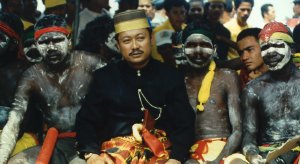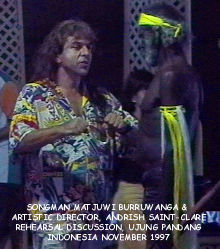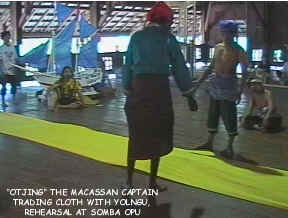Call me non-indigenous?
Source
'When it comes to identity, there's a lot in a name' The Age News Extra, B6, 31/7/99 (1999)
 'In
the beginning, Bunjil created this land and the life within it. He created
people and gave them law.' Or so claims Melbourne's new Immigration Museum,
on the walls of its elegant galleries. This latest version of Australian
history starts with a Koori creation figure and ends with the David Wang
Emporium. Traditional linear history has been outmoded by a sacred foundational
myth.
'In
the beginning, Bunjil created this land and the life within it. He created
people and gave them law.' Or so claims Melbourne's new Immigration Museum,
on the walls of its elegant galleries. This latest version of Australian
history starts with a Koori creation figure and ends with the David Wang
Emporium. Traditional linear history has been outmoded by a sacred foundational
myth.
It's a sign of the times. Rather than grant Aboriginal culture a place within the museum, the museum locates itself within Aboriginal culture. Not only does this transcend the role of indigenous people as victims, but it also evens out the ethnic differences between settlers. In the eyes Bunjil, it matters not whether you are English, Italian or Vietnamese¾ you are all visitors to this land.
Once gathered on the same ground, though, we encounter a tricky problem. What do we call this grouping of non-indigenous Australians? For such an obvious question, it's strange how we rarely we hear it asked.
I confronted it this question by accident one night while walking past Adelaide Railway Station. A man emerged out of the darkness to ask me for a light. I cautiously obliged, and we shared a few words after the fire exchange. As I was about to move on, he asked me what seemed at first a simple enough question, 'Are you a brother, man?'
I stumbled. 'No, I'm an.' I didn't know what to say. If I said I was 'Australian', it would imply my Nunga interlocutor was not. And I felt too Australian to say I was 'European'. If this was New Zealand, I could say 'pakeha', but there is yet no commonly accepted Aboriginal word for 'white person'.
A few weeks later I asked an art curator of Murri descent what my answer should have been. 'There's a word they use up the top end,' she said, 'Balanda'. Balanda? 'Yes, it's the Macassan word for the Dutch, or "Hollander".' It gets stranger-Macassans? 'You know, the sailors from Sulawesi who harvested sea-slug off the coast of Arnhem Land, before Captain Cook.'
This is not the story we learnt in primary school. Could it be that the most likely word for 'white person' in Australia is the Indonesian term for Dutchman? Does the path to reconciliation include a stopover in Southeast Asia?
It's not an unlikely itinerary. Sulawesi is little more than a thousand kilometres from Australia, about the same as the distance between England and Portugal. Annual monsoon winds and regular island stepping stones through the Malay Archipelago make the journey quite reasonable.
Accounts vary about the exact date when Macassans first covered this distance. Though some estimate their arrival in the sixteenth century, Tasmanian professor Campbell Macknight claims that recent evidence confirms the commencement of trade in the 1720s. Macknight's Voyage to Marege' documents the seasonal visits of Macassan fishermen, who spent several months a year catching and processing trepang (sea slug) for Chinese markets. Australians assisted in catching and preparing trepang in exchange for commodities such as knives, tobacco and rice.
At that time, Macassar was capital of the Indonesian Kingdom of Gowa, the map of which included north Australia. Apart from a formidable ship-building prowess, the Makasserese were famous for their epic Ella Galiga, supposedly longest literary work in existence.
Macassan culture has left its mark on the top end. Besides 'Balanda', there are scores of loan words such as 'rupiah' (money) and 'jama' (work)-still in common use. There are also ornamental influences in coloured head-scarves and long tobacco pipes. Perhaps the most profound influence, however, concerns ceremonies. In the Wurramu funerary ritual, the deceased are farewelled by a symbolic raising of the mast, evoking the departure of Macassans north, to the land of the dead. Recently, similar ceremonies have been used in official acts of exchange with the Australian government.
Macassan visits ended soon after Federation. In 1907 the Australian government prohibited foreign fishing fleets in its territorial waters. Apart from memories of the crocheted 'antimacassar' on our grandparent's lounge suites, the Indonesian port (now called Ujung Pandang) plays little part in contemporary Australian culture¾ at least on the surface. A little digging, however, reveals a network of indigenous and Balanda who are renewing this interrupted conversation with our northern neighbours.
Western anthropologists are fascinated by Macassan-inspired ceremonies. The work of Ian McIntosh has been particularly contentious. This recent study of the community at Elcho Island claimed to uncover an Islamic influence, sourced from Macassan contact. Australians were apparently impressed by the customary call to prayer heard from the crow's nests of Macassan ships. The name given to the funerary spirit, 'Walith'Walitha', is interpreted as 'Allah'. Though a long bow indeed, McIntosh's fanciful anthropology does at least suggest that there might be stories in Australian history beyond European grasp.
For many Balanda, this a-European story offers respite from the 'black and white' history that we have inherited. According to Macknight, 'Macassan story is the best example we have that reminds us Australia did not begin with British colonisation. Too many people equate Botany Bay 1788 as the beginning of the nation, but Macassans show that this hasn't always been the case.'
Some feel this personally. The theatre director Andrish St Clair is currently working on an opera about trepanging for this year's Darwin Festival. His own life story stretches across many southern oceans. Born in Hungary, he has since lived in each of the three Southern Hemisphere continents. According to St. Clair, 'My own history is as a migrant, highlighting way the polarised nature of colonisation. In the word "Balanda", I am happy to find Aboriginal story that mentions a third party. As a migrant who doesn't have a stake in Anglo culture, I am excited that this gives me a position.'
Restoration of Macassan contacts began in 1986, with newspaper reports of an old Macassan woman who recalled her father reciting the names of his children in Australia. Some Aboriginal students at Bachelor College recognised these names, and teacher Michael Cooke organised a trip to Ujung Pandang. Thus began a remarkable series of reunions.
In 1993, painter Johnny Bullen-Bullen led a group from Maningrida to Ujung Pendang. Though there were occasions for exchange, such as impromptu discoveries of common language, the event as a whole was too stage-managed to build a lasting relationship. His paintings of Macassans, however, now adorn airports and hotels around Australia.
 In
1996, St. Clair lead a group of half a dozen Macassans to Elcho Island,
where they participated in an exchange of performances. The set included
a Macassan gate and mock prau, around which performers enacted an exchange
of knives.
In
1996, St. Clair lead a group of half a dozen Macassans to Elcho Island,
where they participated in an exchange of performances. The set included
a Macassan gate and mock prau, around which performers enacted an exchange
of knives.
Late in 1997, the Macassans then invited performers from Elcho Island to Sulawesi to participate in the 667th Anniversary of the Kingdom of Gowa. They were led by Charlie Mattjuwi Burrawanga, a Gumatj ritual leader. Burrawanga was the grandchild of one of six wives of the last trepang fisherman.
The performance was centred on a reunion between Burrawanga and his Macassan relatives. Trepang was the main act following the annual processions in front of the local Bupati (Regency). St. Clair describes the atmosphere in front of a crowd of nine thousand as 'like a football game'.
It certainly captured the attention of Southeast Asian media. Three national Indonesian television stations covered the event, and favourable reviews appeared in Indonesian and even Malaysian press. Despite this coverage, the event was ignored by Australian media. Ironically, the obsession with Pauline Hansen had taken more positive Asian exchange off the papers.
Meanwhile, responses to the Macassan story have come from a number of local rock bands. In 1990, the Milingimbi Wirrngga Band released song called 'Takkerena', which was the Macassan name for trepanging camp in area. Three years later, Maningrida's Sunrise Band produced a hit for 3JJJ titled Lembana Mani Mani, the Macassan name for their town.
Fascination with the Macassan story is not limited to non-Balanda. The story of the Macassans epitomises the romance of the seas. On the trail of this romance, the Australian Maritime Museum offers regular tours to the boat-building sites in Sulawesi. In 1988, Peter Spellit from the Darwin Museum reconstructed a Macassan pinisi for a commemorative voyage from Australia to Sulawesi. According to Jeremy Mellefont of the Maritime Museum, the sailors' perspective is different from that of academics: 'Sailors see oceans as what connects people, whereas academics see oceans as what separates them'. Thinking about the rich history of traffic in Australia's northern seas, the British jump leap across to the antipodes begins to seem less original.
 It
may well go back further. There are unconfirmed reports of Chinese people
called Baijini, whose visits preceded the Macassans. While there is no
unambiguous archaeological evidence of their presence, the Baijini feature
in creation era myths. Their textile patterns of coloured triangles (darabu)
supposedly influenced Aboriginal design. And a history of the Sui dynasty
(636AD) records a wilderness called the 'great beyond' where people throw
circular knives and there are two-headed hopping creatures.
It
may well go back further. There are unconfirmed reports of Chinese people
called Baijini, whose visits preceded the Macassans. While there is no
unambiguous archaeological evidence of their presence, the Baijini feature
in creation era myths. Their textile patterns of coloured triangles (darabu)
supposedly influenced Aboriginal design. And a history of the Sui dynasty
(636AD) records a wilderness called the 'great beyond' where people throw
circular knives and there are two-headed hopping creatures.
Australia was situated at the doorstep of a bustling marketplace, where trade was brisk along routes that stretched from the East Coast of Africa to the islands of Japan. It would take very little for one of these boats to stray south. Arab sailors visited Aru, only 500 kilometres north of Australia. Eric Rolls has even speculated that the ancient Phoenicians may have been swept away from their circumnavigations of Africa to the western coast of Australia. And though it stretches historical plausibility to breaking point, it is still remotely possible that a Viking or two might have hitched a ride on an Arab dhow and found himself in this strange Valhalla.
This armchair history might seem fanciful, but it touches a deep nerve in our English sub-cortex. In the nineteenth-century, any English gentlemen with pretensions to scholarship made a study of Phoenicians-the Semites who did indeed walk upon England's shore 'in ancient times'. William Gladstone wrote several books on the subject in between Prime Ministerial duties. In the Devil's Foot, Sir Arthur Conan Doyle placed Sherlock Holmes in Cornwall so he could imbibe 'its sinister atmosphere of forgotten nations' and study the impact of Phoenician tin merchants on the Cornish language. For a nation so obsessed in with its relation to the Holy Lands, Phoenicians offered themselves as a vigorous Semitic people with whom the English could claim a direct contact, however tenuous.
There are the makings of a similar myth here. Before the European invasion occurred, we see a deep relationship between the inhabitants of this continent and their bold neighbours across the seas. Here, perhaps, is the kinship tie we have been desperately seeking with our northern neighbours.
There have already been gestures in this direction. Back in 1987, Australian Prime Minister Bob Hawke used the Macassan story as testimony of the enduring relationship with Asia. To extend this beyond political expediency, however, requires consideration of what we look like as 'Balanda'.
What shape might the word 'Balanda' give to Australian identity? 'Balanda' presents identity through the eyes of first Australians, for whom all European colonists were foreign. It reminds us of distant origins, while remaining uniquely Australia. It offers an indigenous framework for identity without the escapism of a New Age spirituality. It's just the medicine for a republic, but there are some troubling side effects.
According to Murray Garde, the Cultural Research Officer at Maningrida, 'Balanda' has become standard Top End Australian English. Yet to employ it nationally would be to privilege one particular Aboriginal culture over all others. A similar mistake was committed in the 1970s, when the emergence of 'pan-Aboriginality' attempted to dissolve cultural differences through an Esperanto-style indigenous language. One of the movement's participants, John Bunby, has now returned to his Birri Gubba heritage. He emails, 'The people didn't want to give up their own language and culture. It is very difficult to transfer these languages from one country to another because they are so dependent on the landscape¾ the country from which they come.'
Strictly speaking, the term for non-indigenous should depend on the Aboriginal languages of the area, such as 'watjala' in Western Australia and 'migaloo' in Queensland. South-eastern non-indigenes should be called 'gubba'. Depending on who you speak to, this Koori word means either 'ghost' or 'government'.
While it would be wonderful to recover regional Australian identity through Aboriginal difference, it would present a confusing image to the rest of the world. To use the diversity of indigenous cultures as a way of denying a national term would be respectful, but it also sidesteps the issue.
Without 'Balanda', we are left with words like 'settler' or 'whitefella'. Both are flawed. 'Settler' is a generic term, which privileges the early Europeans who cleared the land, rather than the post-war migrants who worked the assembly lines. And while uniquely Australian, 'whitefella' seems a blokey term, with overtones of vaudeville.
In the end, the final word that is chosen may not be as important as the process of selection. It seems an intrinsic part of becoming a republic and achieving reconciliation that we find a word to describe those of us whose ancestors settled here within the past two hundred and ten years. Already, many Balanda are putting up their hands to be counted. What will the next Australian census hold? Perhaps some Koori, Murri, Yolngu, Nunga, Balanda and a few Indonesian tourists.
A version of this article was published in The Age newspaper 31st July 1999

Copyright held by author Kevin Murray
For permission to reproduce this article, please contact Kevin
Murray